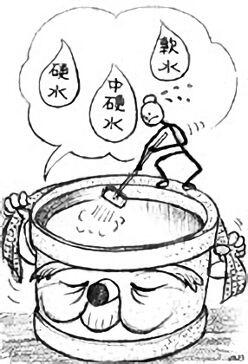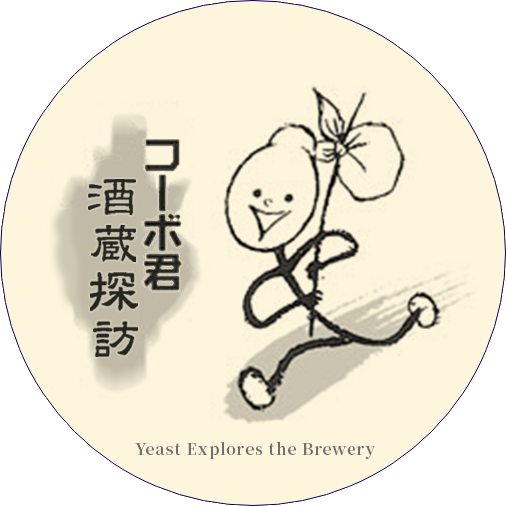| Yeast |
“Hi, Old Well. I’ve been learning about the history and geography of Daishichi, and also about growing the rice. Now I want to know more about the water.” |
| Old Well |
“Fine. We have talked before about the topography of Nihonmatsu, with Mt Adatara to the west, the Abukuma mountains to the east, and in the middle the river Abukuma flowing from north to south. The geological stratum in the west has soft water and the old stratum in the east has mainly hard water. In between these, the stratums in the city are rather complex. But as Daishichi has the granite of the Kannon Hill at the back, its water is medium hard. In the grounds of Daishichi the type of water even differs bit by bit.” |
| Yeast |
“Since long ago the water of your ‘Naka Ido’ has been most suitable for Daishichi’s sake.” |
| Old Well |
“That’s right. Under the ground sits a hard rock mass. The important point is from where to draw the water. The water that wells up from the ridge of the rock mass is the best water. On the other hand, the water that has gathered in the gullies between the ridges is not very good. Daishichi’s well for brewing water (I am talking about myself here!) has been drilled correctly on the top of the underground ridge. Our ancestors have found exactly the right spot.” |
| Yeast |
“Great! And are you very deep?” |
|
 |
| Old Well |
“No, I’m a shallow well. Shallow wells have the best water quality. If there is no good water at shallow places, it’s necessary to dig deep. But then the components that dissolve into the water increase in volume.” |
| Yeast |
“In what way does different water lead to different sake?” |
| Old Well |
“In the past Nada, the famous sake district in Hyogo prefecture, with hard water, was called ‘masculine sake’ and Fushimi in Kyoto with soft water was called ‘feminine sake.’ ‘Masculine sake,’ though at first a bit rough, is at its best in autumn, and ‘feminine sake,’ which in the beginning is rather neat, goes down in quality in autumn. Hard water makes the fermentation also easier. Medium hard water has always been considered as best because it combines delicacy with strength. Recently brewing with soft water has become the trend, because the sake can immediately after production be sent to the Japan Sake Awards which are held in spring.” |
| Yeast |
“For Daishichi the decisive factor is maturation.” |
| Old Well |
“Yes, we are not after quick results. Our sake is delicate, but also improves in quality by undergoing a long maturation process. But although the water is of course important, what decides whether sake is good or bad is the brewing process itself. It is essential to keep the type of the water in mind and use that to best advantage by adjusting the brewing process.” |
| Yeast |
“Is pure water best?” |
| Old Well |
“Of course water has to be pure. But it shouldn’t be like distilled water. The micro-organisms necessary for the kimoto method can’t live in distilled water.” |
| Yeast |
“The water should contain a moderate amount of components. Moderation is also important when cleaning!” |
| Old Well |
“What are you saying? The annual well cleaning is a very important form of maintenance. Underground water is part of the local ecosystem. Water circulates in the ecosystem, and forms a large cycle. The roots of the trees in the mountains give sustenance to it.” |
| Yeast |
“Wasn’t the construction of the new brewery hard on you?” |
| Old Well |
“Not so much, because it was done very carefully. The most important thing was not to damage the underground water course, but to protect it. Large piles were not used. The ground was carefully dug out 3 meters deep, and a floating foundation was made with thick concrete. The water course is protected by a thick layer of clay so it was alright to use short piles. The color of the clay is a beautiful orange, I would like to mold a sake cup with it! When this rich amount of ground water is circulated, it creates a mild atmosphere, which is very suitable for the storage of sake.” |





